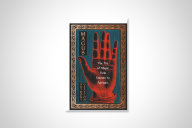You have /5 articles left.
Sign up for a free account or log in.
It is difficult to remember the last time I went to an unfamiliar place, or why, and the prospect of doing so again any time soon remains indistinct and not quite imminent, even with all the encouraging words of late about the COVID vaccines. One day referring to the pandemic in the past tense will start to feel natural rather than like tempting fate. But our neural circuits may take longer to return to their normal settings.
The diversity and exquisite complexity of those circuits -- in particular, the networks of specialized neurons making it possible to locate oneself in space, and to move in it -- are never out of focus for long in Michael Bond’s From Here to There: The Art and Science of Finding and Losing Our Way (Harvard University Press). The author, a former senior editor at New Scientist, is an old hand at translating lab findings into expository narrative. Insofar as he has a topical peg, it is the possible long-term effect of offloading our location- and direction-finding capabilities to global positioning system technology. The book was completed before the coronavirus bullied its way onto the scene. But its interest is not diminished by the fact that whole populations have been forced to move in smaller circles and deeper ruts.
From Here to There is unapologetically anthropocentric, giving little more than a nod to other species’ navigational capacities, and indeed singling out Homo sapiens as having developed “an appetite for exploration and a wayfinding spirit that set us apart from other human species,” such as the less venturesome Neanderthals. Archaeological evidence shows our prehistoric ancestors were able “to travel more than 150 miles to trade, share food and, no doubt, gossip and whinge about each other,” establishing social networks that depended on, and rewarded, spatial cognition: “navigational skills … a sense of direction, the ability to store maps in [the] mind and the motivation to get out and about.”
Fortunately we share a certain amount of comparable neurological hardware with other species, including Rattus norvegicus domestica, a.k.a. the laboratory rat -- enough, anyway, for researchers to have located and monitored specific areas of the brain that respond when exploring a new space or re-entering a familiar one. Besides these “place cells,” there are “boundary cells” that fire whenever the rat is at a certain distance from a wall. And an intricate, tiered system of “grid cells” map space into “a series of equilateral triangles or hexagons,” rather than the sort of Cartesian coordinate system one might expect. (Somewhere in the afterlife, Buckminster Fuller is feeling completely vindicated.)
Of course, most human behavior is more complex than most lab rat behavior, and the comparable sets of location/orientation structures in our brains are integrated into vastly more intricate systems of memory and cognition, which develop (and, alas, decline) over much longer life spans. The analytical distinction between spatial cognition, on the one hand, and the capacity for abstract thought or linguistic communication, on the other, proves untenable when considered at the neurobiological level: “The brain’s spatial system seems to use maps,” Bond writes, “not just to represent space, but to organize knowledge of many different types. It is just as good at navigating our inner worlds as our outer ones.”
Note all the spatial references in just that previous paragraph: “on the one hand … on the other,” “at the neurobiological level,” “inner worlds [and] outer ones.” None of them involves real, literal objects in space. But in each case, mental reflexivity is expressed in terms of direction. Not doing so would be hard, and without any obvious benefit.
So we are biologically hardwired to orient ourselves in space, but a lot can go wrong with the system -- which is, in some ways, even more interesting. From Bond’s account, it appears that a fair bit of research in this area has been done in response to difficult (and sometimes horrific) circumstances for which the human navigational system is unprepared or insufficient. Studies have been conducted to determine the distances covered by children of various ages who wander off by themselves; the itineraries of patients with senile dementia have been investigated by attaching tracking devices to them. And people who lose their way in the woods do indeed find themselves wandering in circles and can fall into what sounds like a dissociative state.
This knowledge can be helpful to rescue teams, though not always. (I don’t know what the next unfamiliar place I’ll visit might be, but it definitely won't be a forest.) But Bond also warns of the potential to squander our evolutionarily endowed spatial awareness through pure neglect. An era of GPS and self-driving vehicles may be convenient but also profoundly forgettable. “We cannot move through the world unaware and not be affected by our lack of knowledge,” he writes. “Memories of places are narratives of what it felt like to be there, and when we pass through oblivious we miss the chance to develop a rich understanding, and a rich remembering.” And if you lose that, what's left?








